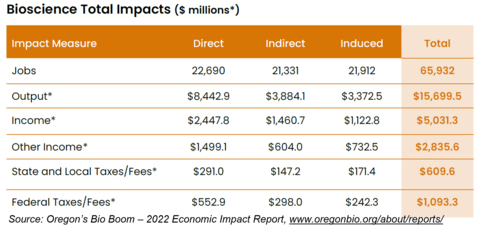PORTLAND, Ore.– ‘New’ money flowing to Oregon’s biotech firms and life science research organizations hit its zenith in 2020.
The new comprehensive study, Oregon’s Bio Boom: 2022 Economic Impact Report, shows Oregon’s biotechnology and life science sector in 2020 exhibited pandemic-ready and recession resilience. Significant and measured gains in almost every indicator and sector reveal total impacts (comprising direct, indirect and induced impacts) show $15.6 billion in output, $5 billion in income and nearly 66,000 jobs statewide. The commercial or ‘private’ bioscience combined with the life science research generated $1.7 billion in local, state, and federal taxes and fees.
“These are the highest numbers we’ve generated in the industry since we started measuring it here in Oregon nearly 20 years ago,” said Liisa Bozinovic, executive director of the Oregon Bioscience Association, the study’s sponsor. “The consistent, upward trajectory story continues.”
Just in the past three years, ‘new’ money from the National Institutes of Health grew in Oregon by 36% to $424 million in 2020, the highest level ever in the state. The average annual wage at life science research institutions was $89,100 in 2020, which is fully 51% greater than Oregon’s statewide average annual wage in private sector employment.
Bioscience in Oregon is also increasingly welcoming women and multicultural workers. In 2020, 75% of the workers in life science research were women. In the combined total count, women make up 45% of the total industry workforce, while ethnic minorities comprise nearly 22% of the total bio workforce.
Alec Josephson, economist with Pinnacle Economics, conducted this current study as well as previous studies for the association. “I’ve had the opportunity to author all six economic impact studies of the bioscience industry in Oregon, starting in 2002, and a few things jump out at me. Mainly, the substantial growth from the study we conducted three years ago shows bio is becoming a pivotal industry in Oregon’s economy.”
He added, “This importance is amplified as bioscience represents a diverse mixture of manufacturing, trade and service sectors which helps to insulate it from contractionary economic factors. Bioscience exports much of what it produces which, along with the substantial NIH funding and venture capital funding increases, bring significant new money here.”
Statewide and federal data show in FY2020, Oregon’s now 1,480 bio establishments directly provided 22,690 bioscience and research jobs with $2 billion paid in direct wages in 2020. Annual wages in corporate bioscience averaged $88,440 in the private sector and in life science research averaged $89,100 in 2020.
And the industry in Oregon has grown its ‘halo’ effect. Josephson noted the economic multipliers have also increased. “From an economic impact perspective, the bioscience industry generates multiplier spending effects that benefit workers and business owners in other sectors of the Oregon economy.” The report reveals an increased employment multiplier of 3.1, which suggests that every 10 jobs in the bioscience industry support an additional 21 jobs in other sectors of our state’s economy.
Additionally, an income multiplier of 2.2 shows that every $1 million in income directly generated in the bioscience industry is linked to another $1.2 million in income for workers and business owners in other industries in Oregon. “The larger the multiplier, the greater the interdependence between the bio industry and the rest of the economy,” explained Josephson.


